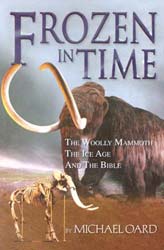|
Frozen in Time by Michael Oard Reviewed by Tim Chaffey |
|
Frozen in Time by Michael Oard is a wonderful book for anyone who is curious about the Ice Age and the Woolly Mammoth. I was really looking forward to this book because this is a subject that is not generally covered in science textbooks. When it is covered, uniformitarian assumptions are presented as fact. So how should a biblical creationist respond to the idea of the ice age? Was there really an ice age that ended about 10,000 years ago as is usually taught? How do we even know if there was an ice age? In addition, what happened the woolly mammoth? Why do we find these creatures frozen in Siberian permafrost, some of them were apparently frozen while standing up? These questions and many more are dealt with in a very readable manner in Oard’s book. Oard begins by giving some information about the mysterious woolly mammoth, which was essentially a very hairy elephant with huge tusks. Millions of these creatures roamed portions of the Northern Hemisphere but are now extinct. What happened to the mammoths? Many people (both creationists and evolutionists) have proposed that they were frozen instantly as a result of an extremely unlikely scenario (i.e. a comet either striking the earth or passing close enough to it to cause a sudden drop in temperature). However, the evidence points to something entirely different. Oard shows the implausibility of these snap-freeze theories and promotes a viable alternative which is consistent with both the biblical and scientific data. This theory posits that the ice age was a result of the worldwide flood described in Genesis 6 – 9. In fact, Oard points out that a worldwide flood is the only mechanism that could ever start an ice age. An ice age can only develop if the average ocean temperatures are much higher than they are now and the average land temperatures are much cooler than today. The worldwide volcanic activity associated with the flood (“fountains of the great deep” – Gen. 7: 11) would produce both of these effects. The oceans would heat up as a result of the hot substances (water, steam, lava) bursting forth from these fountains. The air would drastically cool down because of the massive amount of dust particles projected into the atmosphere. The warmer oceans would allow for greater amounts of evaporation and hence, more precipitation on the cooler continents. The precipitation, falling as snow or sleet, would build up much faster due to the cooler temperatures and within several years would lead to an ice age. As strange as it may sound, the ice age did not kill off the mammoths. They died off near the end of the ice age. Oard provides convincing arguments to explain this as well as many other features of the ice age. Perhaps the most interesting part of this book is the documentation of the complete inability of the uniformitarian approach to explain the origin of an ice age. Mr. Oard has also written a children’s book and a technical monograph on this topic. (2/9/06) |
|
Rating: (9.5 out of 10) About the Author (from back cover) |
